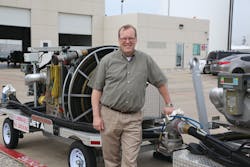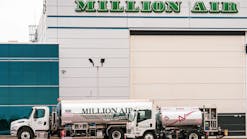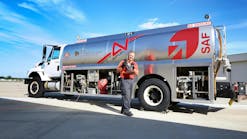By any measure, Southwest Airlines has been a standout success in the aviation industry, earning not only high marks among those who fill its low-cost, no-frills flights, but also consistent profitability.
Just a week or so before wrapping up this issue, the airline reported a record-setting $152 million in net income for the year’s first quarter and appeared well on its way to its financial goal of achieving a 15 percent pre-tax return on invested capital.
With a consecutive streak of 41 profitable years, much of the company’s success sounds like a given. But the recent financial news also came with estimates of winter storms costing $50 million in operating profits.
THE SECRET
So what’s the secret anyway? A talk with Tom McCartin, senior director of fuel management at Southwest and this year's winner of our Ground Support Team Leader award, provides a look at the company’s well-known management philosophy to build a culture of mutual respect with its employees and outside vendors.
McCartin rattles off a number of responsibilities regarding his job.
“The fuel purchasing is probably the easiest part of the job to quantify,” he says, “We buy 1.9 billion gallons of jet fuel a year and distribute it across 97 airports in the United States and the Caribbean.”
The other big part of purchasing a couple of billions gallons of fuel is the some 22 consortiums that require McCartin’s time. But the purchasing might be the “easy” part of the job because then there’s fuel quality.
“Southwest is unique in that for many airlines, the fuel quality team is not part of the fuel department, but the maintenance department,” McCartin adds. “We’re very lucky in that we are involved in the whole process.”
Of course, with all that fuel delivered, stored, used and delivered again comes the fuel accounting aspect of his job.
“It’s a lot of pressure, high energy and lots of hours to make sure that our fueling operations’ expenses are paid, reconciled and that every person involved understand what’s going on and that everything is done on time. So there are a lot of pieces and we’re very lucky here to have a strong team, a very tenured team in our fuel group at Southwest.”
MANAGING RELATIONSHIPS
Southwest succeeds through a culture of mutual respect, where a high percentage of employees "own" their jobs. Log on to the airline’s career page and it’s clear to see: "Not just a career, but a cause."
Sure, McCartin has a team of fuel operations managers that make sure things are done right on the ramp, but the more we talked to him, it became clear that the airline’s tone of cooperation extends to its outside fueling vendors.
Most airlines got out of self-fueling years ago and Southwest is no exception.
“We select the into-plane companies and monitor their performance and if there are any issues on the performance, that's where our operations people come in,” he explains.
While the airline’s refueling contracts are the typical multiyear deals, McCartin walked up through a new service site to help explain how the airlines builds its relationship with outside vendors, such as ASIG or Swissport.
“We hire the company and, of course, we know that they're professionals and that they know how to do things,” McCartin says. “But we coordinate between our airline and the refueler for a good month leading up to the turnover: What do they need? Do they need anything from us? The local station management or the local airport? What is it we can do to help them along.”
In the meantime, Southwest wants to know what the refueler will do on their hiring, whether the fueling equipment has arrived, setup and ready to go.
“Then about a week before the startup, we send our quality team in to take a look and make sure that everything is ready,” McCartin. That includes all the back office support and staff training. “And on the day of the switch, one of our fuel operations managers is going to be on site just to make sure that the launch performs well, that there are no hiccups.”
One hallmark since Day One for Southwest has been its quick turns.
“Our operations manager is on site to make sure that they understand the nature of our quick turns; that it's seven days a week, 24 hours,” McCartin explains. “We educate them on minor things, too, say, our fuel tickets might be different. Basically, anything and everything to make sure that there is a good launch. Then we communicate with them over the next week to make sure everything is good.”
From that point, the airline lets the vendor run the show but, of course, routinely audits and reviews monitor performance and the fuel operations crew stays in the contact with the appropriate managers.
FUEL SEMINAR
Another interesting aspect to vendor relations is an annual day-long Southwest Airlines Fuel Seminar McCartin says the airline has been hosting for 16 years. About 135 people attended this year’s event held last March in Dallas.
“It helps us really keep a finger on the pulse of what's going on with our into-plane and fuel storage providers,” he adds. “We've got the big international name brands, but then we also have much smaller local operators. It's really important for us to keep our communication channel open, and once you bring vendors together, it is amazing the information you hear from the field, that you might not easily.”
Generally, attendees come in the night before to enjoy a “beerbeque” as the airline calls it and which shouldn’t require much of a translation. While the topics change from year to year, the 2014 event featured CEO Gary Kelly, for the first time, and other updates on fuel conservation initiatives at the airline, an overview of international markets with a particular focus on Latin America, fueling equipment maintenance and fueling quality assurance compliance issues.
Last but not least, the airlines hands out annual awards to its top performers, broken down into four levels of station based on the number of flights served.





